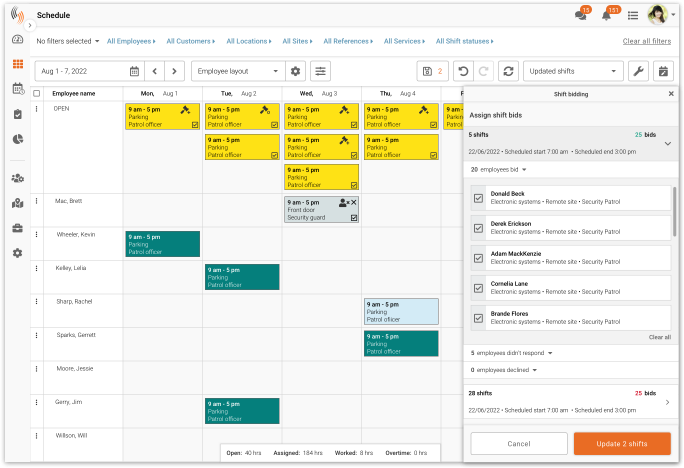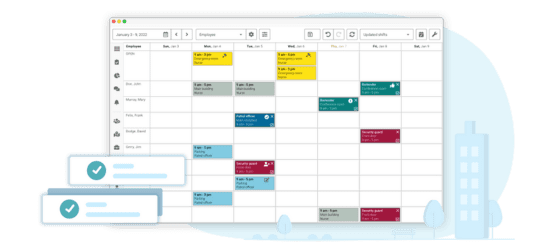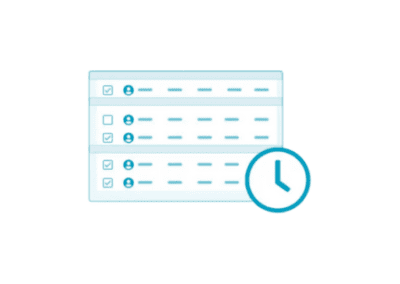Managing a medical practice is no easy feat, and the complexities of nurse scheduling can be particularly challenging. The COVID-19 pandemic has upended traditional scheduling norms, prompting healthcare facilities to turn to nurse scheduling software for a more streamlined transition.
Let’s first look at why nurse scheduling software is so essential right now.
The need for nurse scheduling software

Nursing is widely recognized as the most demanding job in the industry. It is undeniable that nurses’ work-life balance is being compromised at the expense of workloads. These increasing demands are creating both physical and psychological strains, which is leading to an increased degree of burnout cases. Many frontline workers are now looking to consider other options in their careers.
In a recent survey by McKinsey & Company, 22% of nurses indicated that they may leave their position of providing direct patient care in the next year. The significant strain on nurses forces health systems and employers to deploy new strategies to provide a better workforce landscape. The healthcare industry will likely look to rebuild and regain its old strength. But for now, the focus is on allowing nurses more flexibility in their roles. The best way to create that pathway is none other than nurse scheduling software.
So, let’s explore how nurse scheduling software can transform your healthcare business.
The Complexity of Nurse Staff Scheduling
Scheduling nurses is a more intricate task than many other industries. Unlike conventional staff scheduling, nurse scheduling involves a multitude of variables. These encompass business needs, patient requirements, government regulations, hourly stipulations, mandatory break periods, and more.
Additionally, healthcare facilities operate 24/7, which further complicates the scheduling process. Creating efficient and error-free schedules manually is a time-consuming endeavor.
Moreover, nurses come with diverse qualifications and certifications, such as:
- Licensed Practical Nurses (LPNs),
- Registered Nurses (RNs),
- Advanced Practice Nurses (APNs),
- and Certified Nursing Assistants (CNAs).
Managing these various roles efficiently can be a challenging process, often leading to scheduling conflicts.
Managing Nurse-Patient Staffing Ratios
In the United States, federal legislation, such as the Nursing Home Reform Act (1987), sets minimum staffing standards. It mandates the presence of “sufficient staff” to meet resident needs. However, these standards have often been criticized as inadequate.
State regulations vary and may establish higher staffing standards. Still, the need for clarity in these standards can leave facilities with insufficient staffing levels, contributing to nurse burnout and lower patient care standards.
Ensuring the correct nurse-patient ratios is essential for providing high-quality care. Nurse scheduling software enables facilities to analyze patient needs, nurse qualifications, and work-hour regulations to optimize these ratios. This not only enhances patient care but also contributes to nurse satisfaction and well-being.
The Impact on Patient Care

Numerous studies have demonstrated that understaffed facilities with inefficient scheduling provide lower-quality care. Overworked and stressed staff need help to provide adequate attention to residents, which can have a detrimental impact on both patients and healthcare workers. It is evident that before focusing on improving patient care, streamlining the scheduling process is essential to reduce stress and manage workloads without escalating costs.
Managing Overtime and Work Hours
The healthcare industry often grapples with managing overtime and work hours. Nurse scheduling software helps set predefined limits on work hours to prevent excessive overtime. It considers fatigue management, compliance with labor laws, and nurse preferences.
By controlling the hours nurses are allowed to work, the software helps combat the ongoing issue of extended workweeks, which can lead to burnout. Creating a work culture that prioritizes nurse well-being not only keeps nurses content but also enhances their performance levels, making a medical practice more attractive to top talent.
Enhancing Nurse Flexibility
One of the significant benefits of nurse scheduling software is that it empowers nurses with a healthier work-life balance. A recent survey found that 87% of hourly workers consider controlling their work schedules essential. To create a better work environment, medical practices should empower their nurses.
Nurses often have busy lives outside of work. Many are juggling nursing school, work, and further education. Utilizing scheduling features can relieve nurses of additional stress and provide more flexibility.
How Nurse Scheduling Software Can Transform Your Healthcare Business
Real-Time Scheduling for Efficiency
In a fast-paced industry like healthcare, efficient scheduling is crucial. It ensures that operations run smoothly and that nurse performance is optimized. To achieve this, schedules need to be planned well in advance. Nurse scheduling software can help with this.
Providing schedules ahead of time reduces the chances of last-minute changes. It allows nurses to plan their lives outside of work more effectively. The benefits of real-time scheduling are substantial. A Citrix survey revealed that 61% of employees reported working outside the office at least part of the time. So, there is a good chance they are using a smart mobile device to access their schedule.
The manager has the visibility of a live schedule. So, if there is a shift that has been dropped or a missed check-in alert because someone didn’t arrive at the site, they have a range of tools at their disposal. To fill the void, many managers use rules-based scheduling to search for an autofill by qualification or availability. These rules can be set up to prevent overtime and ensure no shift is double-booked. If preferred, managers can use AI-based scheduling tools to discover new rules from historical data. Whichever method they adopt, their schedule will be less time-consuming and far more competent.
In a digital age, nurses can access their schedules online, making it easier to communicate their availability and choose shifts. In case of any changes, they can use in-app chat to inform their managers instantly.
Shift Bidding and Self-Scheduling

Shift bidding and self-scheduling are two valuable features of nurse scheduling software. These features allow nurses to have more control over their schedules. Using an employee app, nurses can input their availability, which provides comprehensive data to assist schedulers in making informed decisions about their schedules.
Additionally, some medical practices may allow shift bidding, where nurses can bid for the shifts they prefer. Research has shown that 89% of companies report improved employee retention rates due to the implementation of such flexible working options. Offering nurses the autonomy to choose their shifts contributes to a happier life outside work and helps prevent burnout.
Streamlining Administrative Tasks
Nurse scheduling software goes beyond just scheduling shifts. It can automate various administrative tasks, such as time and attendance tracking, payroll management, and compliance monitoring. This streamlines the overall organizational process, reduces errors, and ensures that nurses are accurately compensated. It also simplifies compliance with labor laws and regulations, reducing the risk of legal complications.
Enhancing Communication and Collaboration
Effective communication and collaboration are pivotal in healthcare settings. Nurse scheduling software often includes features like in-app chat and real-time updates. These features facilitate communication between nurses, managers, and administrative staff.
Nurses can quickly inform their managers about schedule changes or request time off, ensuring the schedule remains current. This real-time communication minimizes scheduling conflicts, improves transparency, and fosters collaboration.
Monitoring and Analytics

Nurse scheduling software provides valuable insights through data analytics. It allows healthcare facilities to track and analyze various metrics, such as staffing costs, nurse performance, and patient outcomes. With these insights, managers can make data-driven decisions to optimize scheduling, improve patient care, and reduce costs. It also helps in predicting future staffing needs and adapting to changing patient demographics.
Ensuring Regulatory Compliance
The healthcare industry is subject to various regulations, including staffing requirements, licensing, and labor laws. Nurse scheduling software includes features to help healthcare facilities comply with these regulations. It can automatically schedule nurses with the proper certifications and licenses, ensuring the facility meets legal requirements. This reduces the risk of fines and legal issues.
Patient-Centered Scheduling
Ultimately, the goal of nurse scheduling software is to create patient-centered schedules. Patients’ well-being and safety are paramount in healthcare, and scheduling is crucial in ensuring quality care. Nurse scheduling software helps facilities align nurse availability with patient demand, resulting in a higher level of care. It minimizes the risk of understaffing, which can lead to adverse patient outcomes.
Addressing the Growing Demand in Healthcare
The healthcare industry is currently facing substantial changes in its workforce landscape. The objective is to balance the increased demand with more nurses. The U.S. Bureau of Labor Statistics predicts a 12% increase in nursing jobs between 2018 and 2028. This increase is a positive sign, but it also poses challenges.
Categorizing Nurses
Categorizing nurses based on their skills and patient acuity levels can simplify scheduling. Patient acuity levels determine the amount of care required by patients. Nurse scheduling software enables managers to focus on creative and effective ways to apply the skills and certifications of their nursing staff. By ensuring that all nurse records are current, managers can select the right nurses for the right shifts, improving scheduling efficiency.
The Future with Nurse Scheduling Software
Scheduling nurses has become one of the most challenging issues the healthcare industry faces. Due to the stress placed on nurses since the COVID-19 pandemic, the workforce landscape has required dramatic change. Over the last two years, the “great resignation” has seen the healthcare industry lose over 30% of its nurses because of the overwhelming schedules they have had to suffer. So, it’s needed a fresh injection to provide a better working landscape to alleviate the added pressure and give them a platform to enjoy their work again.
Management can use nurse scheduling software to offer flexibility at a time when it can be a game-changer. Nurses have become active participants in this transformation. By empowering them to choose the shifts that create a healthier work-life balance, the healthcare industry is slowly transforming into a more sustainable operation. There’s no desperation to offer overtime or assign an unqualified nurse to a post. Although the most straightforward route would be to stick with tried and tested systems, their ineffectiveness in this desperately critical period is the most significant risk to patients and nurses. Nurse scheduling software is in place to make informed decisions that not only regain the stability the industry used to have but to improve these processes too.
If you are interested in seeing how Celayix could offer a solution to your scheduling problems, take a look at our employee scheduling software and contact us now!





